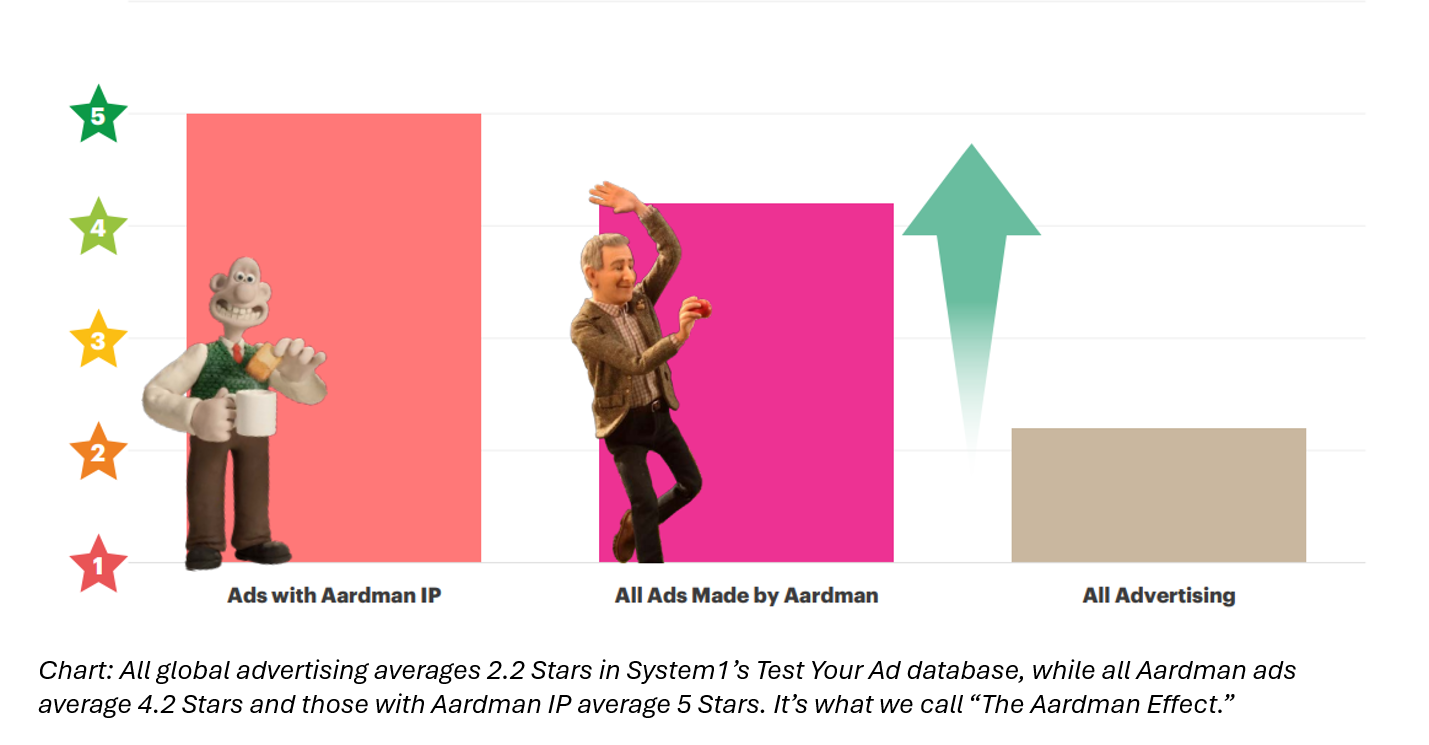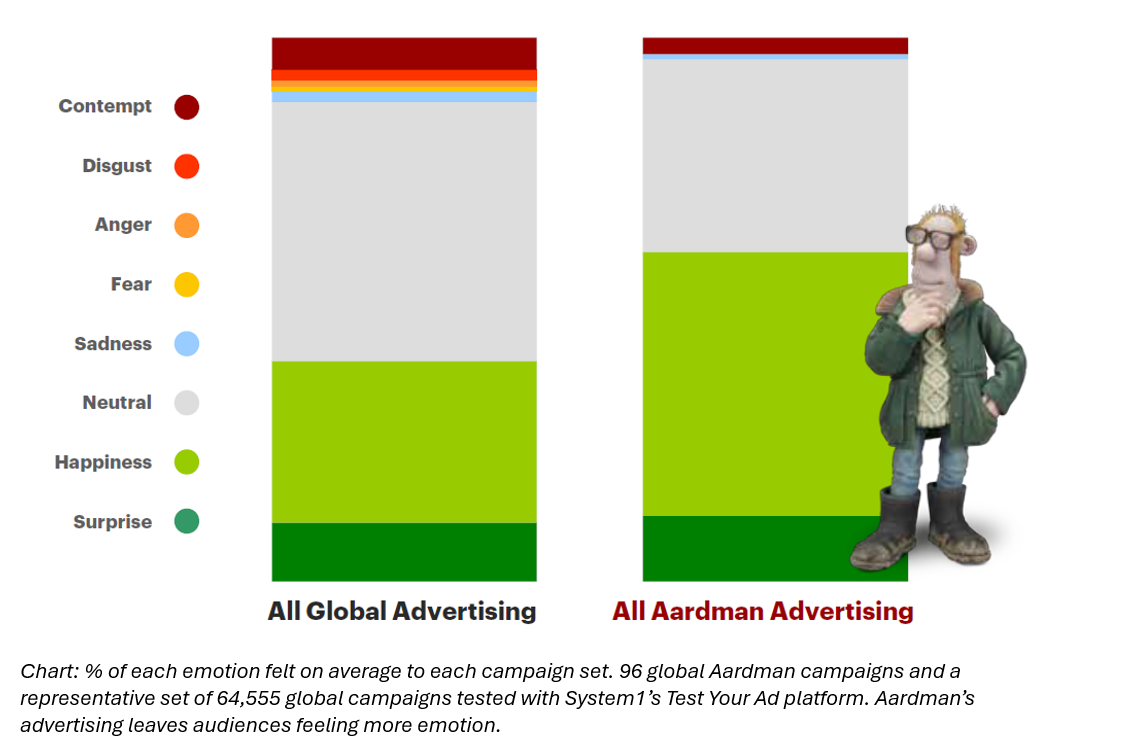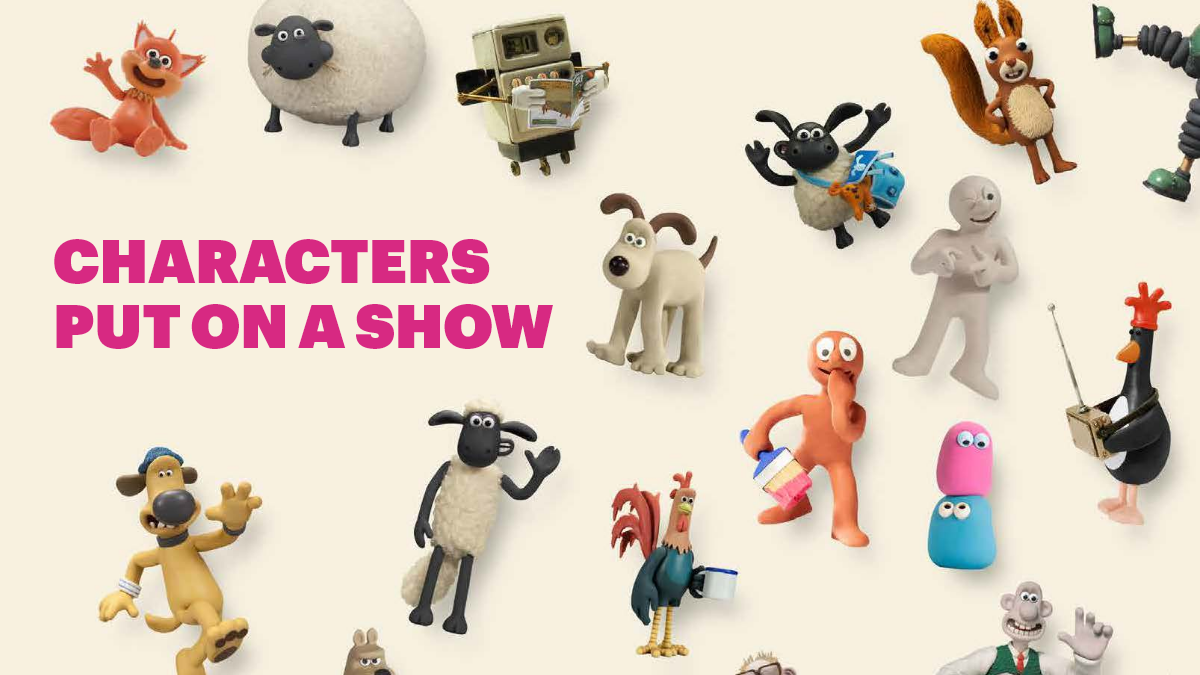Putting On a Show
At System1, we’ve spent years exploring how the emotional response consumers have to advertising predicts its long- and short-term commercial effects. We’ve tested over 165,000 ads worldwide (and you can subscribe to access them via our Test Your Ad database), engaging over 25 million consumers, and linking their creativity to measurable business outcomes. But recently, something out of the ordinary caught our attention.
Ads produced by the animation studio Aardman seemed to consistently perform exceptionally well in our research, almost too well. Aardman is known worldwide for its iconic films and beloved characters like Morph, Wallace and Gromit, Shaun the Sheep, and Chicken Run. But what is less widely known is Aardman’s work in producing commercial advertising for some of the world’s biggest brands. This was worth exploring.
Our deep dive was so inspiring that we set out with the Aardman team to share their approach and creative effectiveness lessons in our book Putting On a Show. For 40 years, Aardman has developed iconic films as well as commercial work for brands, introducing characters such as Lurpak’s Douglas, Maynard’s Scotsman and the Thatchers family.
Let’s take a look at what marketers can learn from Aardman’s success.
Exactly How Good is Aardman at Engaging Audiences?
Our research found that Aardman aren’t just good at making emotionally resonant work, they’re exceptional. All global advertising averages 2.2 Stars in System1’s testing (out of a maximum 5.9 Stars). All ads made by Aardman average 4.2 Stars and those featuring Aardman intellectual property (IP), well known by audiences, average 5 Stars.
This means that all Aardman ads average ‘Strong’ brand-building potential and those that borrow the likes of Wallace, Gromit, Shaun the Sheep, etc. break into ‘Exceptional’ brand-building potential.
So, how do they achieve such high effectiveness metrics? In the next section, we’ll explore the power of characters.

Characters Put On a Show
Advertising demands brevity. Unlike feature films or television series, ads must deliver a compelling narrative in mere seconds. Characters are one of the most effective ways at capturing attention and evoking emotion, which is essential for driving commercial effects.
Aardman works with brands on ads for everything from mattresses to marshmallows. While the brand and narrative shift from project to project, one thing that remains central to Aardman’s work is the characters and the craftsmanship that goes into their development. There is exquisite attention to detail, building out unique personalities and worlds for these characters.
As a result, Aardman’s characters elicit a higher level of Happiness compared to all global advertising, as evidenced by System1’s FaceTrace™ measurement, which showcases the second-by-second emotional response that consumers have to advertising.

There are a few different ways that characters can put on a show. Each strategy is effective at driving short- and long-term effects and is one that Aardman is well versed in.
1. Leveraging Familiar Faces
Often, brands borrow Aardman’s famous IP, infusing stories with characters that are already widely recognized and put on a smile on people’s faces. In the best cases, like Barbour, the brand commits to leveraging the same characters over the long term so that they become consistent fluent devices, appearing in numerous scenarios.
For the 2023 festive period, Barbour employed Shaun the Sheep and the Farmer to showcase its high-quality wax jackets. The characters were the perfect fit for the narrative and didn’t overshadow the brand, which can be a risk when borrowing well-known IP. In testing, 88% of viewers correctly attributed the ad to Barbour.
The next year, a follow-up brought the characters back for more fun on the farm. Both ads scored ‘Exceptional’ on long-term brand-building potential, with the first iteration landing the maximum 5.9-Star score in System1’s testing and the sequel scoring 5.6-Stars, along with ‘Strong’ short-term sales potential. It’s proof that characters deliver on both the long and the short when used thoughtfully.
2. Creating your Own Character
The second approach to character work is for Aardman to create customized brand-owned characters that can appear across the marketing mix. Aardman’s iconic 90s Lurpak campaign introduced Douglas, a man made entirely of butter. In one ad, Douglas’s spirited personality and humorous interactions with a refined female narrator showcased Lurpak’s fresh taste and premium quality with a playful, satirical twist.
The ad and the wider campaign is celebrated for its character design and animation. Douglas is filled with playful expressions and exaggerated movement, which embodies the fresh, light-hearted nature of the brand. The character’s witty interactions with the towering, elegant narrator serve as a clever metaphor for Lurpak’s ability to bring joy and a touch of indulgence to everyday moments.
3. Updating Characters with Aardman’s Style
The final strategy when featuring characters is to revive familiar brand characters through Aardman’s distinctive animation style, as witnessed in work for Nestlé’s Chocapic.
Aardman’s skillful claymation puppetry brings Pico, a fluent device familiar to audiences for over 30 years, into a new light. By reviving him from 2D animation to claymation, the ad creates a wave of nostalgia, reminding viewers of childhood memories and the original magic of Chocapic, all while keeping the product central to the story. The ad achieved 4.2-Stars (‘Strong’ brand-building potential) in testing and ‘Exceptional’ short-term sales potential.

Why Characters are Essential
Great advertising begins with a story, and the most effective ones put characters at the heart of these narratives. They give us someone to care about, root for, or laugh with. As Orlando Wood explains in his book Look out, characters are not just decorative; they are emotional anchors that draw us into the world of the story. They connect with the right side of our brain, the part that understands relationships, empathy, and emotion.
Strong characters are full of agency and vitality. A character with agency actively drives the story forward, making choices, solving problems, or reacting to the events around them. Vitality is what makes characters feel alive. They move, express, and interact in ways that resonate. Orlando Wood calls this unique essence quiddity, the specific traits that make a character stand out. It could be a memorable gesture, a particular way of speaking, or a look. Quiddity gives characters their individuality.
Equally important is the betweenness of characters, the way they interact and connect with others. Advertising that shows characters interacting, through a shared glance, a humorous exchange, or even a moment of conflict, feels richer and more compelling. These connections amplify the emotional pull of the story, making it feel authentic and human.
Characters are also the drivers of drama that engages audiences. Stories come alive through moments of action and change. These incidents are the turning points that propel a narrative forward, revealing character and evoking emotion. They capture our attention by creating tension, surprise, or resolution, keeping us hooked as the story unfolds.
Whichever approach to characters your adopt – borrowing beloved IP, creating your own character or updating a distinctive asset in a studio’s signature style – they should employ unique characteristics that will capture attention and drive positive emotion. And to maximize their commercial impact, don’t forget to let your characters charm audiences across a variety of channels and campaigns. There’s magic (and effectiveness!) in entertainment.
Don’t miss the full version of Putting On a Show, System1 and Aardman’s joint publication exploring stories with character, characters with heart and advertising with a smile.

